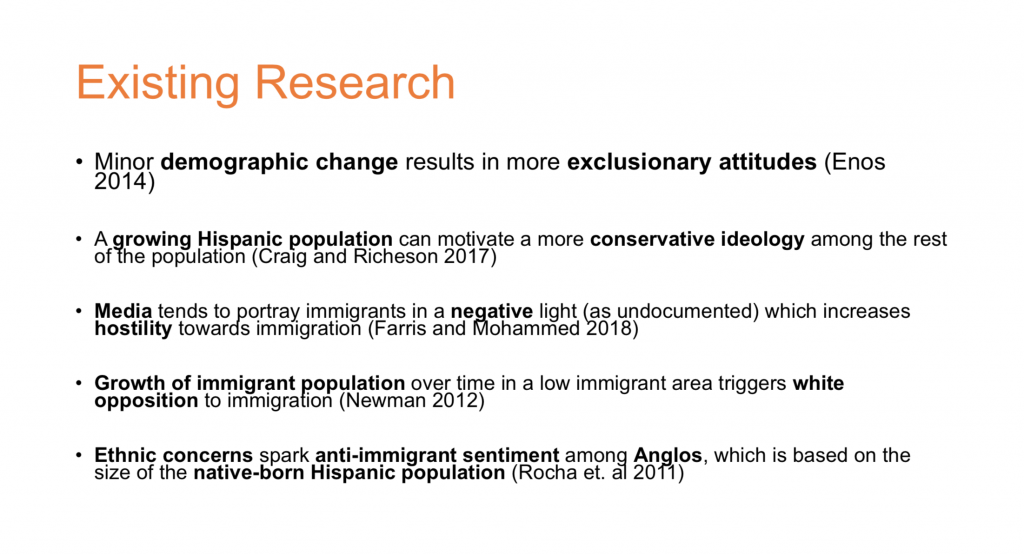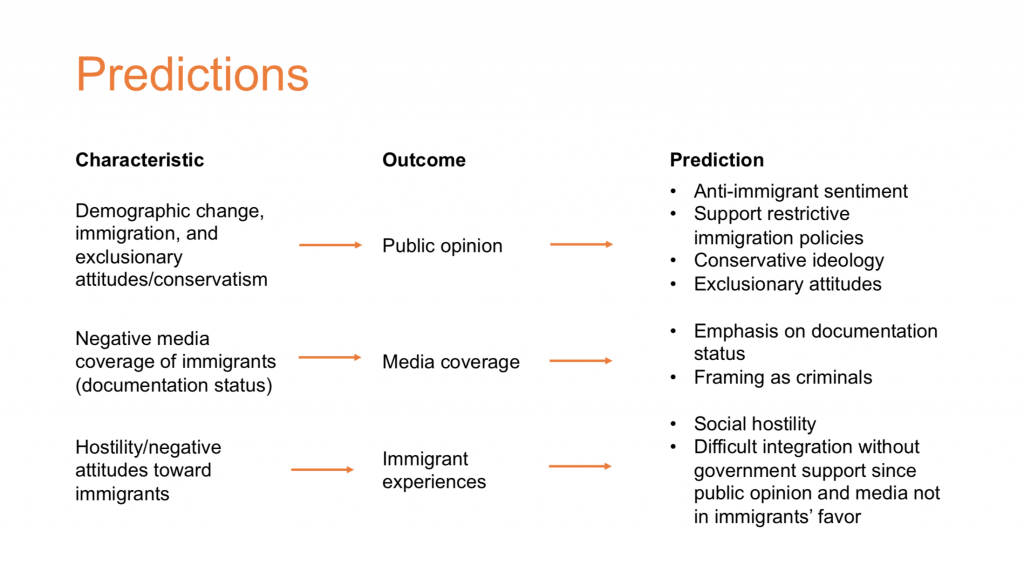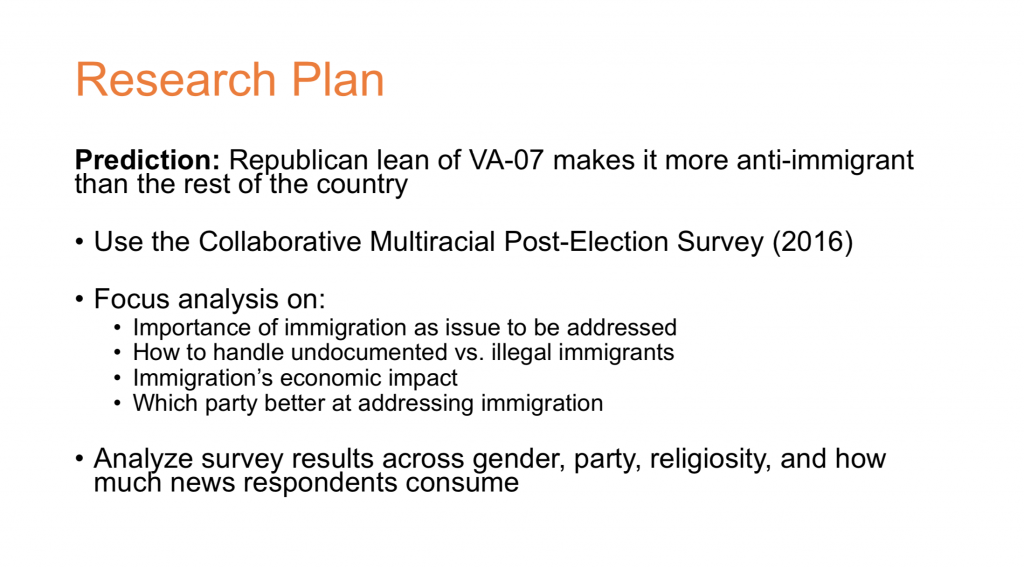
Abigail Spanberger represents Virginia’s seventh congressional district in the U.S. House of Representatives. The district is located in the suburbs of Richmond, VA, and its representative is a member of the Democratic Party.
Map from: https://www.govtrack.us/congress/members/VA/7
Photo from: https://abigailspanberger.com/

This slide shows the demographic change of VA-07 from 2007-2017 — the 11th Congress to the 115th Congress. Therefore, these district demographics are from before Abigail Spanberger was elected to represent VA-07. Clearly, the district has remained incredibly white over the decade, yet the percentage of the population that is white has decreased by 6.3 percentage points. The Asian-American population has been increasing relatively steadily, and the Hispanic/Latino population was also increasing until it began to drop off again between 2015 and 2017 (decreased by 2.1 percentage points). It is important to note the comparatively large increase in the Hispanic/Latino population between 2013 and 2015 (a 4.2 percentage point increase). This increase coincided with the district’s increasing conservatism, as in the 2014 midterm elections, the VA-07 electorate voted out incumbent Republican Eric Cantor — a party leader — and replaced him with the ultra-conservative Tea Party Republican Dave Brat (see Assignment 1). This is important in the context of the increasing foreign-born population in the district. While the district is overwhelmingly comprised of native-born Americans, the foreign-born population has been increasing since 2013 — the same year the district experienced a spike in its Hispanic/Latino population. Perhaps then the relationship between the immigrant population and the Hispanic/Latino population prompted the district to become more conservative, which as the next slide will show, is consistent with existing literature.
Demographics information from: https://factfinder.census.gov/faces/tableservices/jsf/pages/productview.xhtml?pid=ACS_10_1YR_S0501&prodType=table

Existing research on immigration and demographic change shows a great deal of white resistance. As Enos (2014) showed in his experiment, minor demographic change in an area results in more exclusionary attitudes. However, this is not the only effect of an increasing minority population as Craig and Richeson (2017) also showed that an increase in the Hispanic population can motivate a more conservative ideology among the rest of the population in the area. This is consistent with the fact that the more conservative party — the Republican Party — is associated with more restrictive immigrant policies (see Assignment 1). Perhaps then, this is why the VA-07 electorate became even more conservative and voted for the more conservative candidate in the 2014 midterm elections after experiencing an increase in the Hispanic/Latino population. Further support for this comes from Newman (2012) who found that an increase in the immigrant population in a low-immigrant community triggers the white population’s opposition to immigration. This is because a relatively recent change in the immigrant population is more noticeable in a low-immigrant community like VA-07 rather in an area with a high immigrant population already. Of course, VA-07 is largely comprised of native-born residents, so Rocha et al.’s (2011) finding that anti-immigrant sentiments among Anglos result from ethnic concerns which are driven by the size of the native-born Latino population. This could have also contributed to the shift seen in 2014 since even though the immigrant population in VA-07 increased, the native-born population has been an overwhelming majority. The media also does not help improve the situation for immigrants since the media tends to portray immigrants in a negative light, showing them as undocumented, which increases hostility towards immigration (Farris and Mohammed 2018). Therefore, even without a wealth of literature on the immigrant experience, the existing literature about immigration and demographic change as well as how the media represents immigrants shows that immigrants often have negative experiences. As immigrants attempt to integrate, they are met by the exclusionary and conservative attitudes and negative media environment scholars have identified. Even though VA-07 elected a Democrat in 2018, it is still unlikely — given the history of conservatism in the district — that the situation for immigrants has improved.

Considering the demographic change in the district and the existing literature on immigration, demographic change, and the media, which inform an understanding of immigrant experiences, several predictions can be made. For the characteristic of demographic change prompting more exclusionary and conservative attitudes, the impact is on public opinion of the other residents in the community. This also encompasses an increase in immigration since the relevant studies about immigration and attitudes have focused on racial and ethnic minorities which then change the area of interest’s demographics. Given the demographics of the district over the last decade and the existing research, for the outcome of public opinion I predicted that VA-07 is full of anti-immigrant sentiment and a conservative ideology. This is due to the fact that both the Asian-American and Hispanic/Latino populations have increased over the last decade (despite the slight 2017 decline for the Hispanic/Latino population) and how the district has consistently elected conservative candidates until 2018, when Spanberger narrowly won her election. Therefore, most of VA-07 has exclusionary attitudes as a result of this demographic change and the residents also likely support restrictive immigration policies, consistent with the district’s Republican lean. In terms of the media coverage immigrants receive, which focuses on their legal status and thus presents them negatively as undocumented, the outcome here is media coverage, and the predictions are that in VA-07, the media will emphasize immigrants’ documentation and frame them as criminals. This would be consistent with the literature as well as with the district’s Republicanism which hints to a negative immigration attitude and thus media coverage. Of course, the media can also be influencing VA-07’s immigration attitudes, which is why the two outcomes of public opinion and media coverage must be studied to see how immigrant experiences may be impacted. As immigrants face hostility and negative attitudes socially and through media coverage, the outcome in question is immigrant experiences, and I predicted that as immigrants try to integrate into VA-07 they will face social hostility in addition to a lack of government support. In turn, this hostility and lack of institutional support create an overall negative experience for immigrants in VA-07.

I plan to focus my future research on public opinion, specifically. I predict the Republican lean of VA-07, which was found in Assignment 1, makes public opinion in VA-07 more anti-immigrant than the rest of the country, despite the fact that in 2018 the district elected a Democrat. To study this, I will use the Collaborative Multiracial Post-Election Survey (CMPS) from 2016. During this time, the district was still being represented by Tea Party Republican Dave Brat, showing how conservative the district was becoming after experiencing some demographic change. The CMPS is a survey conducted after each election to measure the attitudes of voters and non-voters on a variety of political social issues, one of which is immigration. I will specifically focus on the importance of addressing immigration, how respondents feel undocumented immigrants should be handled (focusing on how “undocumented” vs. “illegal” changes the responses), immigration’s economic impact, and which party is viewed as better on the issue of immigration. I hope to study these across party first of all, and also gender, news consumption, and religiosity. I will then compare the results of my statistical analysis to that of the country overall. I will adjust the scope of the study as necessary as I proceed through the research process.
Honor Code
This assignment represents my own work in accordance with University regulations
– Morgan Bell